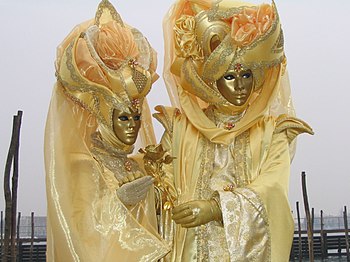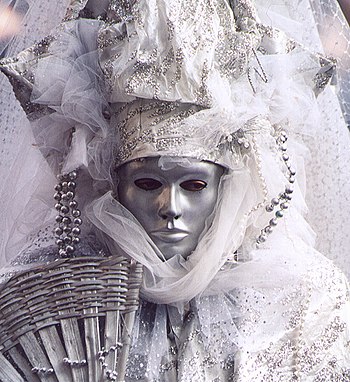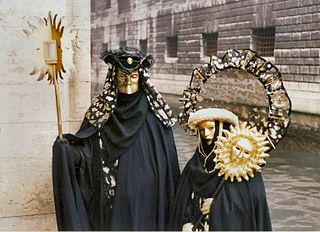Carnival of Venice: Difference between revisions
ClueBot NG (talk | contribs) m Reverting possible vandalism by Barneyloverrocks to version by 98.145.92.214. False positive? Report it. Thanks, ClueBot NG. (920761) (Bot) |
|||
| Line 47: | Line 47: | ||
==Mask-makers == |
==Mask-makers == |
||
The ''mascherari'', or mask-makers had their own statute dated 10 April 1436. They belonged to the fringe of painters and were helped in their task by sign-painters who drew faces onto plaster in a range of different shapes and paying extreme attention to detail. |
The ''mascherari'', or mask-makers had their own statute dated 10 April 1436. They belonged to the fringe of painters and were helped in their task by sign-painters who drew faces onto plaster in a range of different shapes and paying extreme attention to detail. Hi, this is about the carival of the magical land of fairies, not of venice! |
||
Venetian masks feature prominently in the film ''[[Eyes Wide Shut]]''. In the film, the main character (played by [[Tom Cruise]]) infiltrates a masked ball where high ranking individuals engage in secret orgies and [[freemasonry|masonic]] rituals. |
Venetian masks feature prominently in the film ''[[Eyes Wide Shut]]''. In the film, the main character (played by [[Tom Cruise]]) infiltrates a masked ball where high ranking individuals engage in secret orgies and [[freemasonry|masonic]] rituals. |
||
Revision as of 01:19, 1 March 2012



The Carnival of Venice (Italian: Carnevale di Venezia) is an annual festival, held in Venice, Italy. The Carnival starts 58 days before Easter[1] and ends on Shrove Tuesday (Fat Tuesday or Martedì Grasso), the day before Ash Wednesday. "A carnevale, ogni scherzo vale!" In other words, "At a carnival, every joke goes!"
History
This section needs expansion. You can help by adding to it. (March 2011) |
It is said that the Carnival of Venice was originated from a victory of the "Repubblica della Serenissima", Venice's previous name, against the Patriarch of Aquileia, Ulrico in the year 1162.[2] In the honor of this victory, the people started to dance and make reunions in San Marco Square. Apparently this festival started on that period and become official in the renaissance. After a long absence, the carnival return to operate in 1979.[3] The Italian government decided to bring back the history and culture of Venice, and sought to use the traditional Carnival as the centerpiece of their efforts. Today, approximately 3,000,000 visitors come to Venice each day for Carnivals. One of the most important events is the contest for the best mask, placed at the last weekend of the Carnival. A jury of international costume and fashion designers votes for "La Maschera piu bella". Here are the first prize winners of the last years:
- 2012 : "Teatime" (il servizio dal te de settecento) by Horst Raack; also, the first prize for the special category "Most Inventive Costume" to Jacqueline Spieweg from Germany for "Oceano".
- 2011 : "La Famille Fabergé" by Horst Raack, shared with "Omaggio a Venezia" by Paolo and Cinzia Pagliasso and Anna Rotonai; also, the first prize for the special category 19th century to Lea Luongsoredju and Roudi Verbaanderd from Belgium
- 2010 : "Pantegane" from Great Britain
- 2009 : "The Voyages of Marco Polo" by Horst Raack and Tanja Schulz-Hess from Germany
- 2008 : "Luna Park" by Tanja Schulz-Hess
- 2007 : "La Mongolfiera" by Tanja Schulz-Hess[4]
Venetian carnival masks
Masks have always been a central feature of the Venetian carnival; traditionally people were allowed to wear them between the festival of Santo Stefano (St. Stephen's Day, December 26) and the start of the carnival season and midnight of Shrove Tuesday. They have always been around Venice. As masks were also allowed on Ascension and from October 5 to Christmas, people could spend a large proportion of the year in disguise [1]. Maskmakers (mascherari) enjoyed a special position in society, with their own laws and their own. It is celebrating the death of there ancesters --98.145.92.214 (talk) 03:58, 29 February 2012 (UTC)--98.145.92.214 (talk) 03:58, 29 February 2012 (UTC)'Bold text' guild.
Venetian masks can be made in leather or with the original glass technique. The original masks were rather simple in design,decoration, often had a symbolic, and practical function.[5] Nowadays, most of them are made with the application of gesso and gold leaf and are all hand-painted using natural feathers and gems to decorate.

Bauta
Bauta (sometimes referred to as baùtta) is the whole face, with a stubborn chin line, no mouth, and lots of "gilding". One may find masks sold as Bautas that cover only the upper part of the face from the forehead to the nose and upper cheeks, thereby concealing identity but enabling the wearer to talk and eat or drink easily. It tends to be the main type of mask worn during the Carnival. It was used also on many other occasions as a device for hiding the wearer's identity and social status. It would permit the wearer to act more freely in cases where he or she wanted to interact with other members of the society outside the bounds of identity and everyday convention. It was thus useful for a variety of purposes, some of them illicit or criminal, others just personal, such as romantic encounters.
In 18th century, the Bauta had become a standardized society mask and disguise regulated by the Venetian government.[6][7] It was obligatory to wear it at certain political decision-making events when all citizens were required to act anonymously. Only citizens had the right to use the Bauta. Its role was similar to the anonymizing processes invented to guarantee general, direct, free, equal and secret ballots in modern democracies.
It was not permitted to wear weapons along with the mask, and police had the right to enforce this ruling.
Volto or Larva
The "Volto" was the more common mask used in Venice for centuries. Volto means "face", and it was the simplest mask to produce.
Mask-makers
The mascherari, or mask-makers had their own statute dated 10 April 1436. They belonged to the fringe of painters and were helped in their task by sign-painters who drew faces onto plaster in a range of different shapes and paying extreme attention to detail. Hi, this is about the carival of the magical land of fairies, not of venice!
Venetian masks feature prominently in the film Eyes Wide Shut. In the film, the main character (played by Tom Cruise) infiltrates a masked ball where high ranking individuals engage in secret orgies and masonic rituals. Stores that supplied the masks include both Ca’ Macana[8] and Il Canovaccio[9] in Venice. The latter displays the original mask worn in the film by Tom Cruise on their website.
Cultural References
Carnevale is depicted in the 2009 video game Assassin's Creed II. The main character, Ezio Auditore, is assisted by the artist Leonardo da Vinci in hunting down and assassinating the corrupt Doge of Venice during Carnevale; a golden mask, which Ezio must obtain to enter a private party held by the Doge, plays a significant role in this part of the game.
References
- ^ Tieuli, Michel. "A Short History of Venetian Carnival Masks". Retrieved 13 February 2012.
- ^ Carnival History
- ^ Venice Attractions, Carnival
- ^ Davis, Robert C. (2004). Venice, the Tourist Maze: A Cultural Critique of the World’s Most Touristed City. Berkeley: University of California Press. pp. 35–50 & 246–60.
{{cite book}}: Unknown parameter|coauthors=ignored (|author=suggested) (help)CS1 maint: extra punctuation (link) - ^ Nalesso, Roberta. ""The Maks of Venice". Meeting Venice.it.
- ^ Ignatio Toscani: Die venezianische Gesellschaftsmaske. Ein Versuch zur Deutung ihrer Ausformung, ihrer Entstehungsgründe und ihrer Funktion. Diss. Saarbrücken 1970.
- ^ Wiele, Johannes, "Licence to Mask: The Venetian Bauta Mask as a Historical Anonymization Device"
- ^ See Pauline Frommer's Italy by Keith Bain, Reid Bramblett, Pippa de Bruyn, William Fink, Barbie Latza Nadeau p. 333
- ^ Frommer's Northern Italy: Including Venice, Milan & the Lakes by John Moretti p. 168
